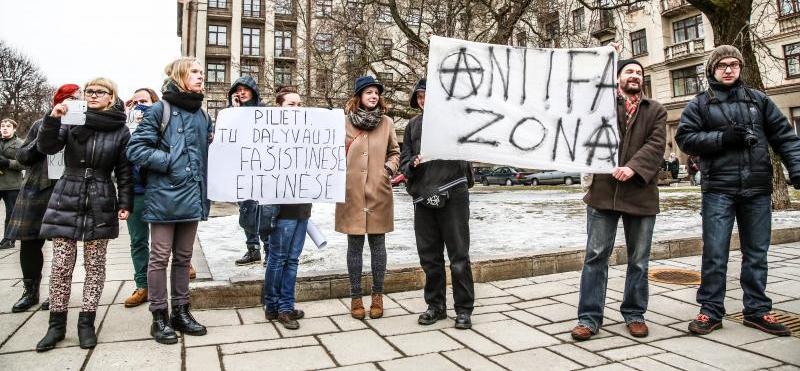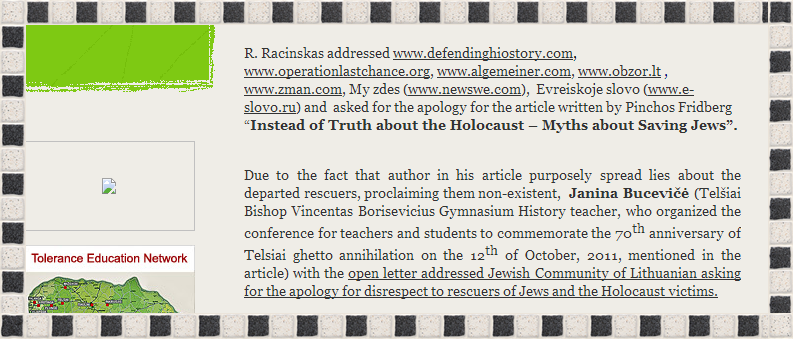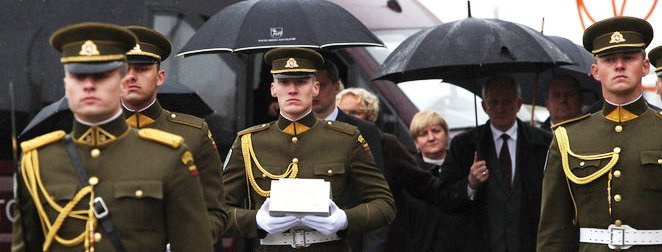O P I N I O N
by Pinchos Fridberg
Editor’s note [with updates to 3 March 2013]:
Editor’s note [with updates to 3 March 2013]:
Editor’s note: This adapted translation from the Lithuanian original, by Geoff Vasil, has been approved by the author.
On February 16 I visited Kaunas. I heard the neo-Nazis would try to desecrate the nation’s freedom, for which people of the country of all ethnicities had struggled. Sadly, the neo-Nazis are now shouting loudly: “Lithuania for Lithuanians…”
One of the organizers of the march boasted the vanguard of the march would be carrying a portrait of Ambrazevičius.
It’s worth recalling what sort of person he was. In 1941 Ambrazevičius led the Provisional Government formed by the LAF (Lithuanian Activist Front), the Provisional Government which called Lithuanian policemen to serve the Nazis, set up a concentration camp (at the Seventh Fort, where it all ended in the murder of several thousand Jews), and even while realizing the Nazis no longer needed their service, this gang went on to promulgate the “Regulations on the Situation of the Jews,” which legally deprived their neighbors of human rights, while on the ground armed people were already murdering Jews throughout Lithuania.

The author and his friends and colleagues who constituted the small “anti-fascist zone” at the March 16th neo-Nazi parade in Kaunas, Lithuania on the occasion of the nation’s independence day.
Readers and supporters of Defending History likely realize there is a diversity of opinion and views held by contributors (made explicit on the About us page), and in that spirit I’d like to share my own impressions of the neo-Nazi march on Lithuanian Independence Day 2013 in Kaunas (Kovno), Lithuania’s second-largest city and the provisional capital in the interwar period.
First, Kaunas was colder than expected. The breeze contributed to the chill. There seemed to be half as many police as protestors at the staging area, Ramybės Parkas, next to the bus station in central Kaunas. The police wore three uniforms: green, grey and, I was told by someone representing himself as being from Interpol, a large number of plain-clothes officers dispersed among the crowd, presumably meaning the marchers, since the number of protestors was paltry, just a handful of people.
See also the memoirs of Evaldas Balčiūnas, Dovid Katz (and 2nd), Efraim Zuroff

Somebody’s idea of “tolerance education”? Extract from the official website of the “International Commission for the Evaluation of the Crimes of the Nazi and Soviet Occupation Regimes in Lithuania” (known for short as the “red-brown commission”)
Educators, diplomats, historians and journalists thought they had seen it all when it came to Holocaust-in-Lithuania issues in recent times. But an online attack by the state sponsored “history commission” on a local Holocaust survivor, Professor Pinchos Fridberg, who is deeply involved in honoring righteous Lithuanians who saved a Jewish neighbor, because he expressed his views against distortion of the Holocaust? That is a bit much even for here.
UPDATE of 21 February 2014:
One year later: Defamation continues on Commission website;
See Chronology of a Debate and what Pinchos Fridberg actually said…
Translator’s note: The original article in Lithuanian with all the graphics is available at https://defendinghistory.com/vienos-provokacijos-fotografijose-chronika/49453.
An email was sent to the Lithuanian Jewish Community at the end of the work-day on February 5, 2013:
From: Janina Bucevičė siwe22@gma…. Sent: 4:56 P.M. February 5, 2013 To: info@lzb… Subject: response to article Hello, I read Pinchos Fridberg’s article on your internet publication which refers to a conference I organized. I would like to correct certain facts in that article. For that reason I come to you with an open letter. Thank you. Respectfully, Janina Bucevičė attached: Janina Bucevičė.doc
The email contained as an attachment an open letter, a portion of which you can see below:
The following is a translation of the 10 February blog of Artūras Račas, editor-in-chief of Baltic News Service (BNS). Only embedded links (marked by underlining) have been added, along with editorial editions enclosed in square brackets [ ], enabling readers to better follow Mr. Račas’s attacks on Holocaust survivor Professor Pinchos Fridberg and Holocaust historian Dr. Efraim Zuroff, director of the Simon Wiesenthal Center Israel office.
Artūras Račas, head of Baltic News Service (BNS), the main news agency in the Baltics, in a tweet today heaped scorn on Vilnius Holocaust survivor Professor Pinchos Fridberg and on the director of the Simon Wiesenthal Center’s Israel office, Dr. Efraim Zuroff. The tweet is reproduced below and links to the tweeter’s article, which is also available in English translation [updates: Prof. Fridberg’s reply; later report].
As readers of Defending History are aware, many American citizens and others who care deeply about the memory of the Holocaust being accurately transmitted have been devastated by the shift in US State Department policy toward appeasement of far-right Baltic revisionism, apparently in the context of various geopolitical issues. The topic is the focus of a section of DH.
BACKGROUND READING
Vilnius native and life-long resident Professor Pinchos Fridberg sent the following question to the leadership of the Jewish Community of Lithuania (JCL), and received the following answer. These official English translations, accepted by JCL, are reprinted verbatim, with permission from the website of the Jewish Community of Lithuania, where the question appears here and the reply here.
I’ve never met Christine Beresniova, but I’ve followed her career, so to speak, through the media and mutual acquaintances, and wish her only the best. She first came to my attention after apparently making some very limited and not very public criticisms of Lithuanian Holocaust education, which sufficiently pissed off the Holocaust Obfuscation establishment ensconced within the corridors of state power for them to label her some kind of Russian agent in informal conversations.

The blog Christine Beresniova and Rokas Beresniovas recently published the article “A lamentable absence of sexy scandals.” We will refrain from comment on their understanding of the concept “sexy scandals” and stick to the work of fellow human rights advocates, which entails standing up to powerful establishments on behalf of minorities, victims of prejudice, and in the case of Eastern Europe, the victims (and handful of survivors) of genocide. Those who stand up know all too well that to do so is not all that often convenient, easygoing or self-serving.
An important new paper by Dr. Per Anders Rudling of Lund University, Sweden, has appeared in the new volume, Analysing Fascist Discourse: European Fascism in Talk and Text. The collective volume brought out by Routledge (New York & London) is edited by Ruth Wodak and John E. Richardson.
Dr. Rudling’s paper, entitled “The Return of the Ukrainian Far Right: The Case of VO Svoboda” comprises the sections:
The small courtroom in the building of the Lithuanian Supreme Court a few yards away from the nation’s Seimas, or parliament, was packed with journalists and mostly older generation nationalist opponents of Algirdas Paleckis. Two judges, speaking in different sections, upheld the earlier verdict against him for having proposed a version of events for January 13th 1991 that is at odds with national historiography.
The Lithuanian government sponsored “International Commission for the Evaluation of the Crimes of the Nazi and Soviet Occupational Regimes of Lithuania,” known for short as the “Red-Brown Commission” has recently added a new layer of obfuscation and opacity to its activities.
Its website has deleted the names of the “Members of the Commission” thereby rendering it a kind of “secret society.”

 Remains of 1941 fascist leader Juozas Ambrazevičius (Brazaitis) met by honor guard at Vilnius Airport on 17 May 2012 and reburied in Kaunas’s Church of the Resurrection on the 20th, as city’s mayor dismisses criticism.
Remains of 1941 fascist leader Juozas Ambrazevičius (Brazaitis) met by honor guard at Vilnius Airport on 17 May 2012 and reburied in Kaunas’s Church of the Resurrection on the 20th, as city’s mayor dismisses criticism.SEE ALSO:
Collaborators Glorified section
Previous sanitization program